

After the great excitement and beneficial knowledge from the Shoemaker-Levy event, NASA decided to stage an impact of its own, this time on a comet rather than a gasball planet. The comet chosen is Tempel-1, discovered in 1867 by George Tempel. Here is a telescope view of Tempel-1 when it was close enough to the Sun in August of 2001 to develop a tail; the bright circular area is the comet's coma.
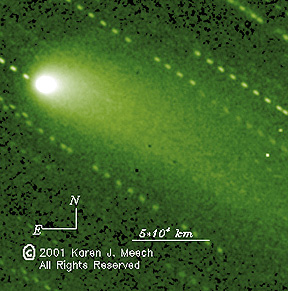
The rationale behind the mission, named Deep Impact, is simple: A probe sent from the mother ship onto the comet's surface should produce an impact crater, whose size, for the velocity and mass parameters chosen, can tell much about the nature of the material making up the surface and into the interior. A nose-mounted camera in the impactor will show progressive closeups of the target area, much like the Rangers did for the early days of lunar exploration by crashing onto the Moon. Instruments on the surviving mother ship can observe the impact and make measurements of the debris thrown off the comet for days thereafter. This mission, the 12th in the Discovery series, has a price tag of $333 million dollars. You can read more about the mission on this NASA website.
Here is the Deep Impact spacecraft as it rests completed at its fabrication site:
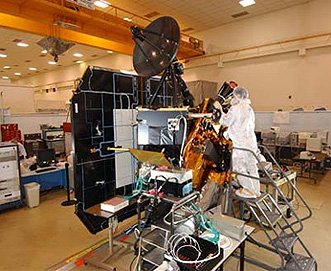
Launch date was January 12, 2005 from Cape Canaveral. The transit time was deliberately set for arrival, impactor separation, and impact itself on July 4, 2005 as part of the U.S.'s "birthday" celebration. Here is the orbital history.
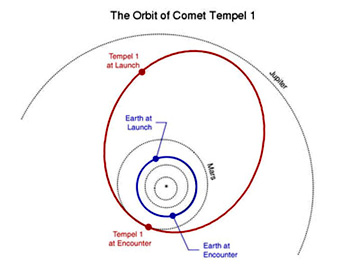
In the weeks prior to the impact telescopes trained on Tempel-1 observed events that proved to look very much like the July 4th impact. These have been noted on comets many times in the past. Two explanations seem most likely: 1) there is an internal gas release which ejects material outward; or 2) some object in space collides with the comet causing a fireball and ejecta. The first illustration below was made through the Hubble Space Telescope on June 14, 2005:
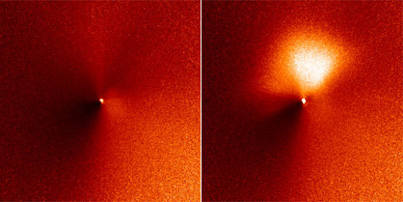
The second explosive event was on June 22 and was observed directly by the video camera on Deep Impact. The escaping plume lasted well beyond 5 hours.
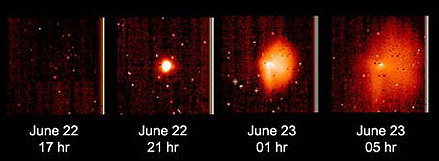
A spectrometer on board were able to determine some of the constituents in the plume:
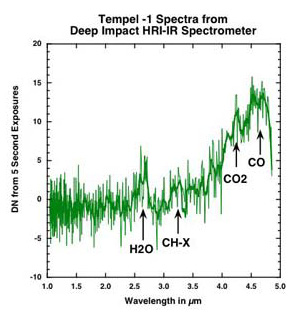
On July 3, 2005 Deep Impact approached Tempel-1. Technicians and scientists at JPL awaited anxiously the final minutes. Some 12 hours before impact the impactor was successfully released from the mother ship and hurtled its way towards the advancing comet. The collision was designed to combine the orbital velocity of the comet with the opposing velocity of the impactor to attain a net impact velocity of 10.2 km per second (6.2 miles per second) or 37360 km per hour (23000 mph). For a mass of the impactor at 330 kg (820 lbs), the K.E. generated at this speed is equivalent to 4.5 tons of TNT. At the time of impact, 1.52 AM EDT, the comet was 134,700 km (83000 miles) from Earth.
As it closed on target, this view of Tempel-1 was obtained.
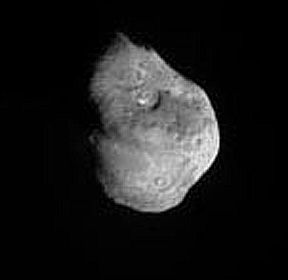
The next two scenes show part of the comet's surface and then a close-up moments before the impactor struck about 60 meters from its pre-selected target.
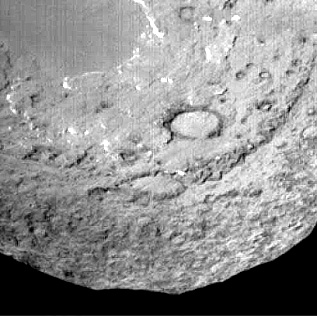
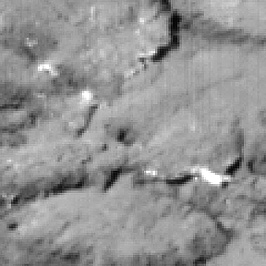
At almost the exact instant of collision, this image was acquired by the mothership.
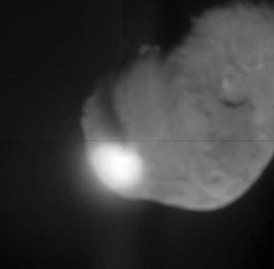
Just seconds thereafter this image was obtained:
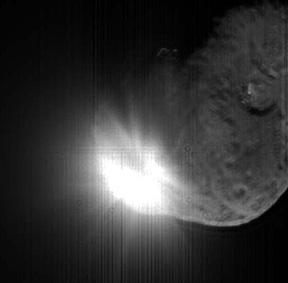
The moment immediately at impact, as imaged from the Deep Impact mother spacecraft, shows the luminous fireball at its maximum extent; the dark area is the comet, the bright is the fireball.
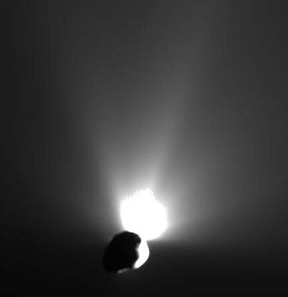
This fireball contained two sources of light: 1) superheated materials from the comet; and 2) light from the Sun reflecting from particles. As the ejecta plume continues to be maintained, it will lose the luminosity of the heated cometary substances but will continue to reflect sunlight. The plume was still glowing 5 hours after impact and will continue to be monitored from the mothership and telescopes over succeeding days. The crater itself was not visible during the first few days, attesting to the masking ability of the still dense debris in the plume.
Telescopes worldwide were trained on Tempel-1. The best view from a distance was obtained through the Hubble Space Telescope:
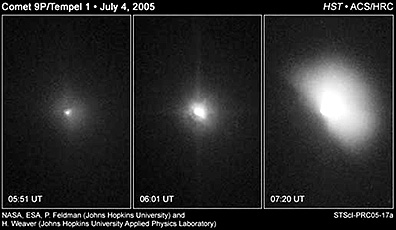
European Space Agency telescopes produced some of the most informative observations. The 8.3 m telescope at La Silla captured this visible light image that shows the dispersal of gas and particulate debris soon after the impact.
An NTT telescope yielded an image in which the ejecta plume could be roughly density-sliced to indicate variations in the amount of light-scattering debris. The coma of the comet is within the square.
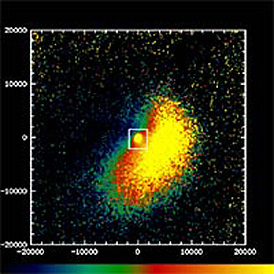
The Optical Ground Telescope in the Canary Islands examined the ejecta using a red filter and a C-2 filter, with these results.
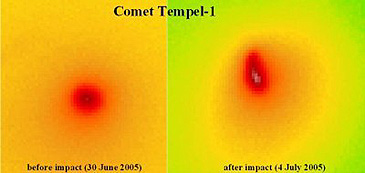
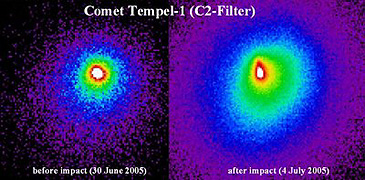
An image from the mothership taken 55 minutes after the impact showed the extent of the still expanding ejecta curtain beyond the comet:
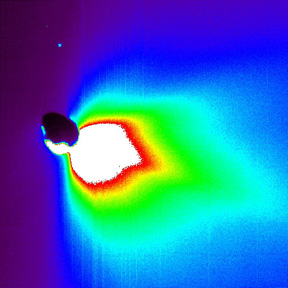
Interpretation of this material has led to the conclusion that most of this curtain is composed of fine dust (face powder consistency), with some water vapor/water. The picture being derived from Tempel-1's surface is that it contains more solids, and less ice, than expected.
Calculation of the amount of dust ejected helps to estimate the size of the new crater as between 100 to 200 meters (up to 650+ feet in diameter).
So far, only a little specific science results have been released to the scientific community and the public. What is shown above is mainly observational. Unfortunately, the mothership is a flyby configuration and is receding from the comet. The dust may not clear enough to get a good look at the formed crater, as had been hoped. Whether any system will detect the crater at a later time is still uncertain.
But, in September 2005 scientists made this statement: Analysis of the dust made from the Spitzer spacecraft shows the presence of silicates (including Olivine), as expected, but also small amounts of materials that appear to be clays and carbonates (unexpected). Aromatic hydrocarbons were also detected.
What is really wanted are actual samples of asteroid or comet nucleus materials. Plans for such missions are being worked out. However, as was discussed on page 19-22, on May 9, 2003, the Japanese Space Agency launched the asteroid probe Hayabusa towards a very small asteroid, Itokawa, which is only about 3 km (9000 ft) in long dimension and almost 0.7 km (2000 ft) in cross-sectional dimension. Here is a repeat view of Itokawa:
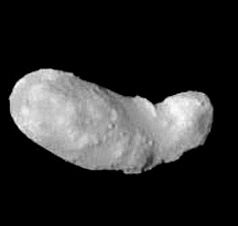
Itokawa was reached in late September 2005. A tiny rover, MINERVA, was sent to its surface to observe with its cameras and temperature probes. It failed to transmit evidence of a successful landing (either it crashed, instruments malfunctioned, or the craft capsized so that the antenna does not point towards Earth). But more ambitious (and risky) were the attempt(s) to set the mother ship down, sample the surface materials, and have Hayabusa take off for a return (with samples) to Earth for a parachute landing in Australia in June, 2010. The first try was aborted. But in November 2005 a landing and possible sampling occurred. The mother ship appears to have left the comet's surface successfully and is back in a parking orbit but details of sample procurement are sketchy and confusing. Hayabusa will attempt to return to Earth in February 2010 and release any samples in a re-entry capsule but its recovery remains a challenge.
A review of the Haybusa Mission is found at thisWikepedia website.
Thus endeth this great voyage of exploration through the Solar System! The previous 18 Sections should have convinced you that our Earth is an extraordinary, yet very livable place. But, this Section hopefully has opened your eyes to the fact that the rest of the Solar System, while inhospitable, is clearly fascinating in its own right. Recently, astronomers have discovered several new planetary systems elsewhere in our galaxy. Who knows what incredible worlds lie beyond our own? Perhaps someday we’ll remotely sense a sister planet and then, when the technology develops, visit it by probes or even by our species.
In the meantime, what should be the priorities in future exploration of the Solar System. NASA, ESA, the Russians and other space programs will make these decisions. But input from the public - especially space connoiseurs - who "foot the bill" - is very much desired. The writer (NMS) has his own favorite 'top of the list': Mars! We now know enough to realize that if that planet had only been larger (thus holding more of its atmosphere) and its potential biogenic development could adjust to the decreased solar energy it receives then it may well have been a favored host for life to develop. As it is, the possibility has yet to be ruled out. Rovers and orbiters will help in the search. Man's visit would be decisive.
Some of the "flavor" of future exploration plans is covered in a JPL von Karman lecture. Access this at von Karman lectures, choosing the topic "Space and Earth Exploration:2020, November 21, 2002.
Now it is time to expand our remote sensing horizons towards Infinity to show how this technology lies at the heart of the exploration of the whole Universe. The next Section, 20, may be the most provocative of all.
